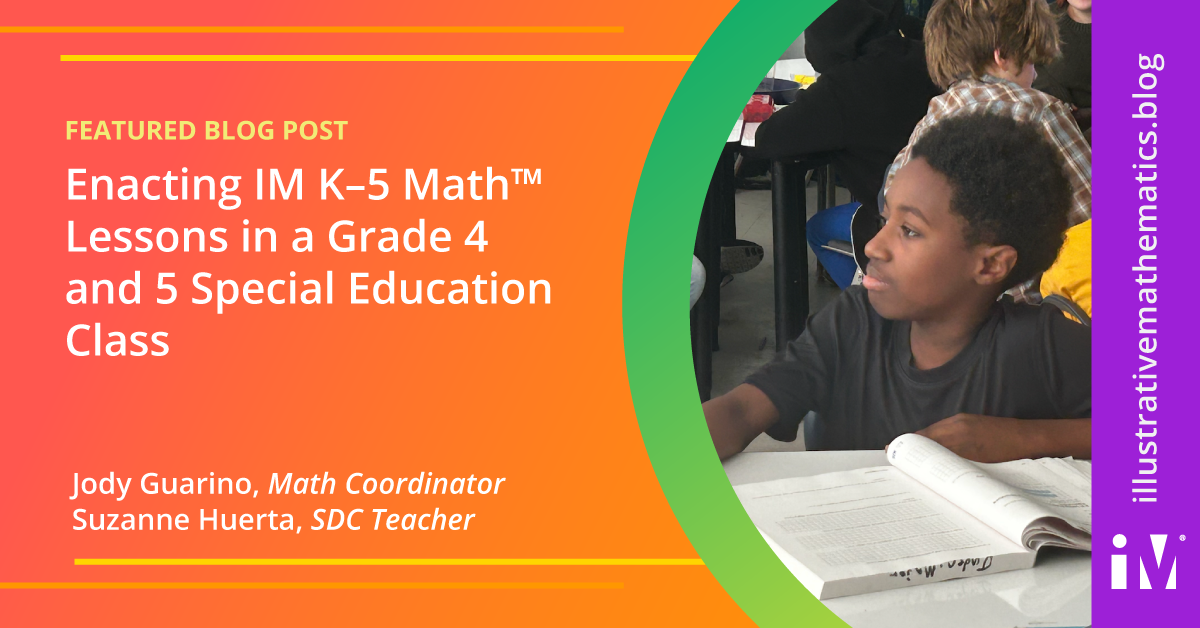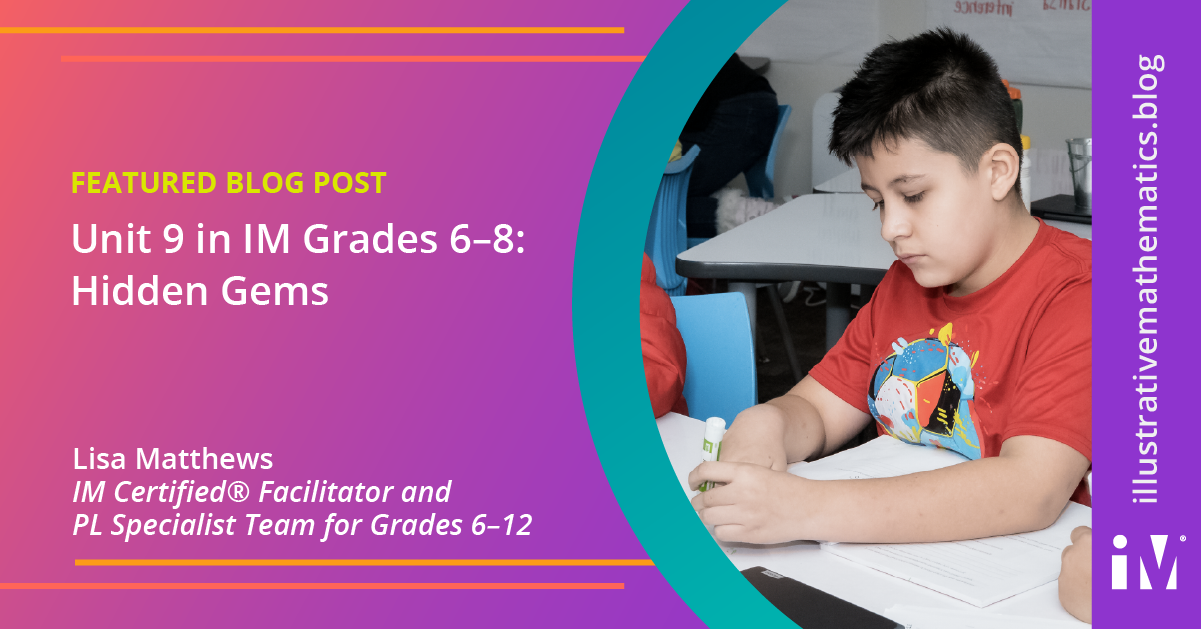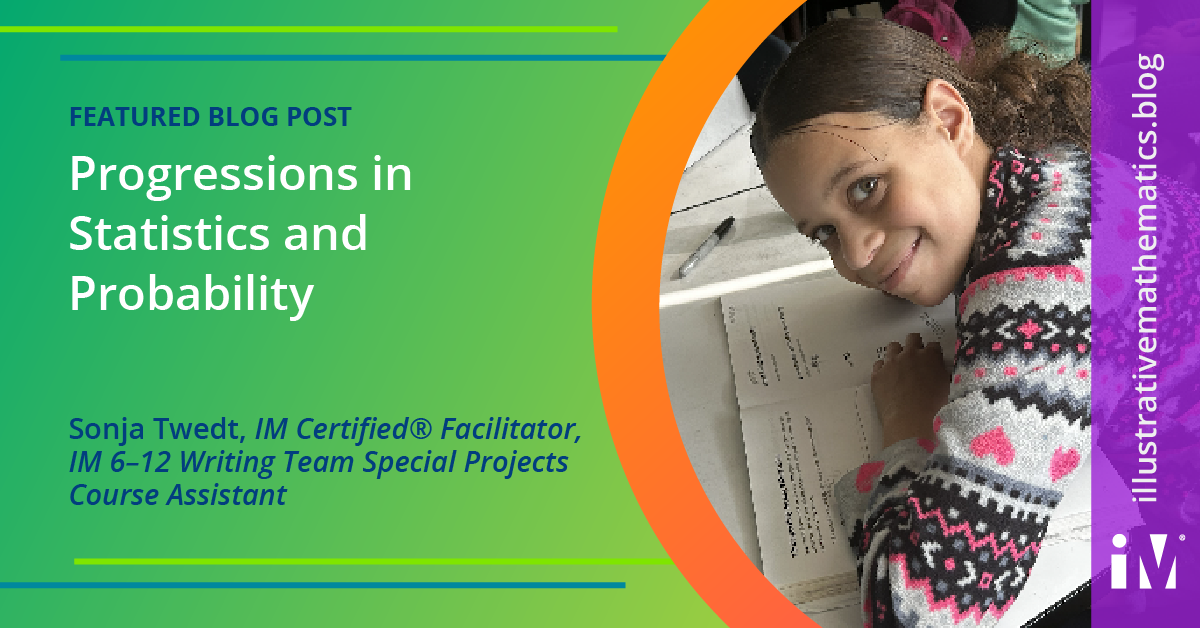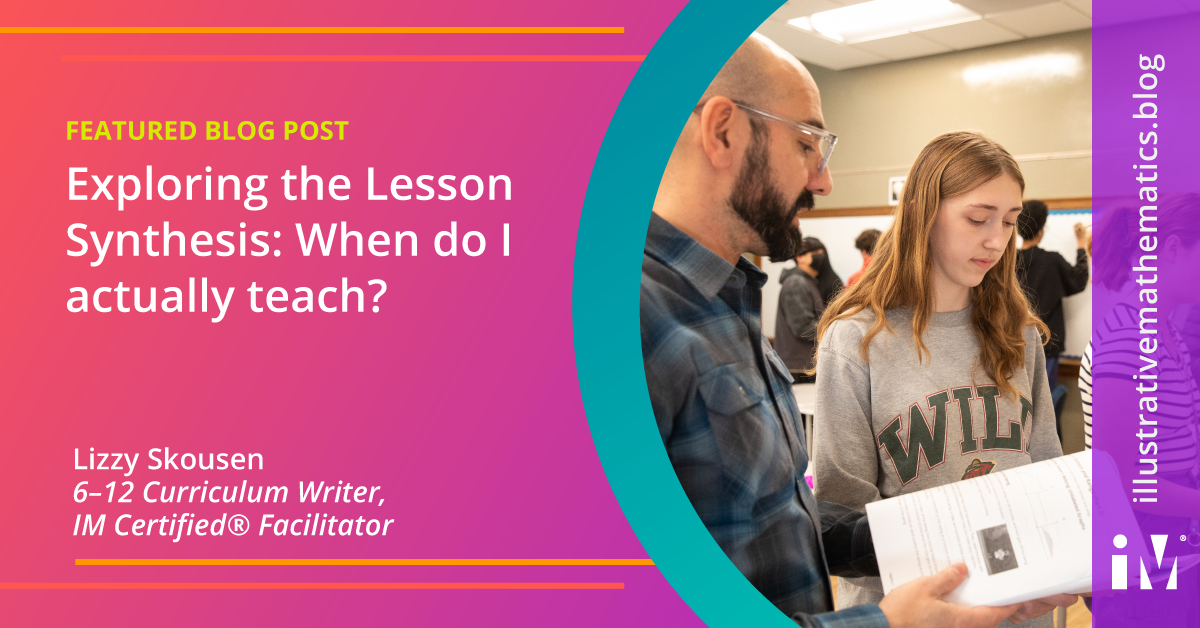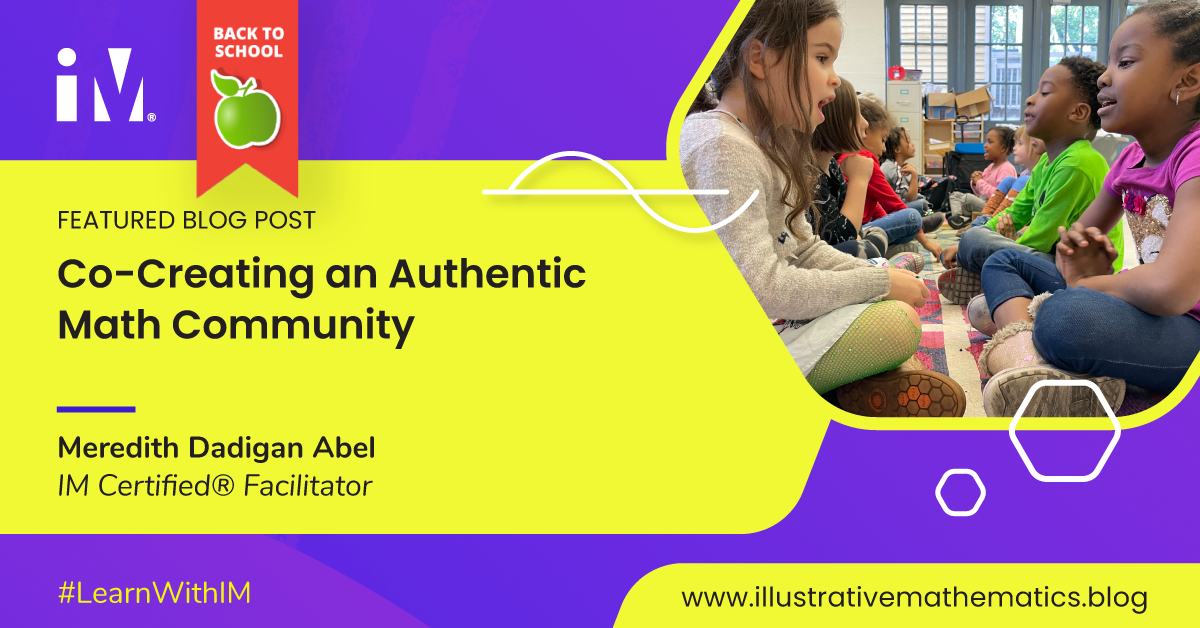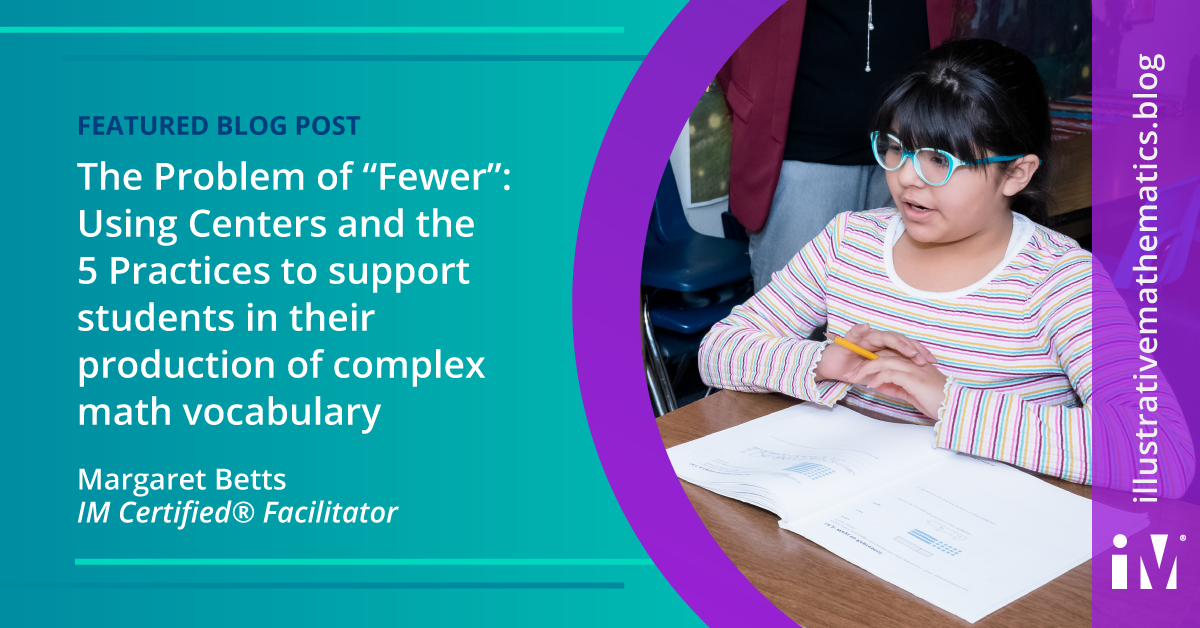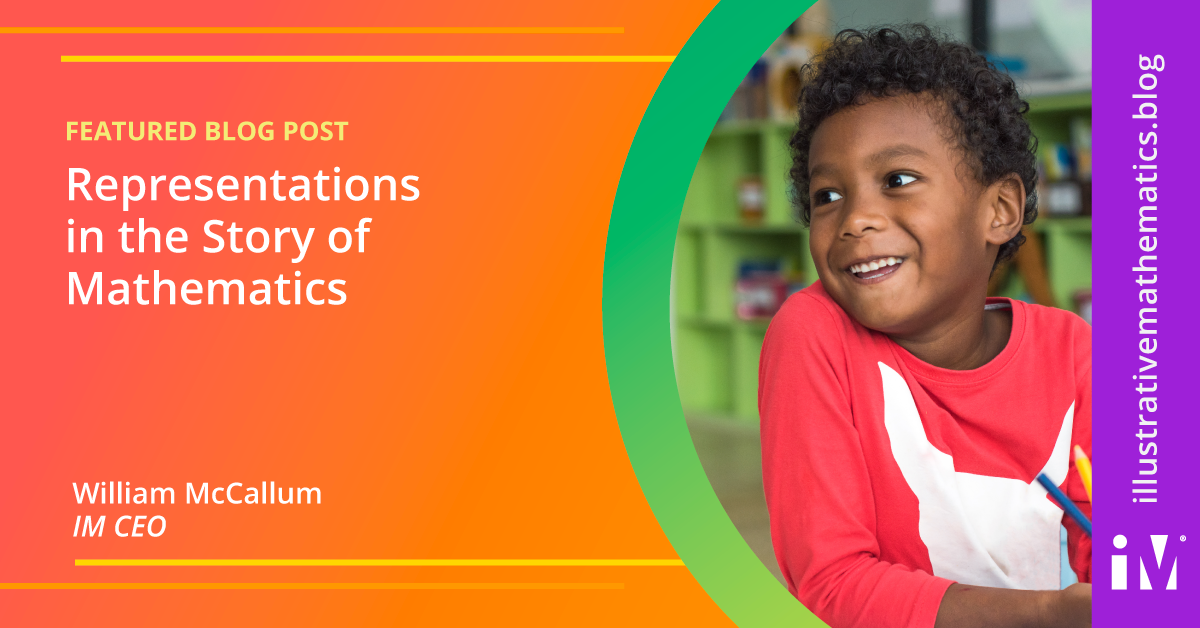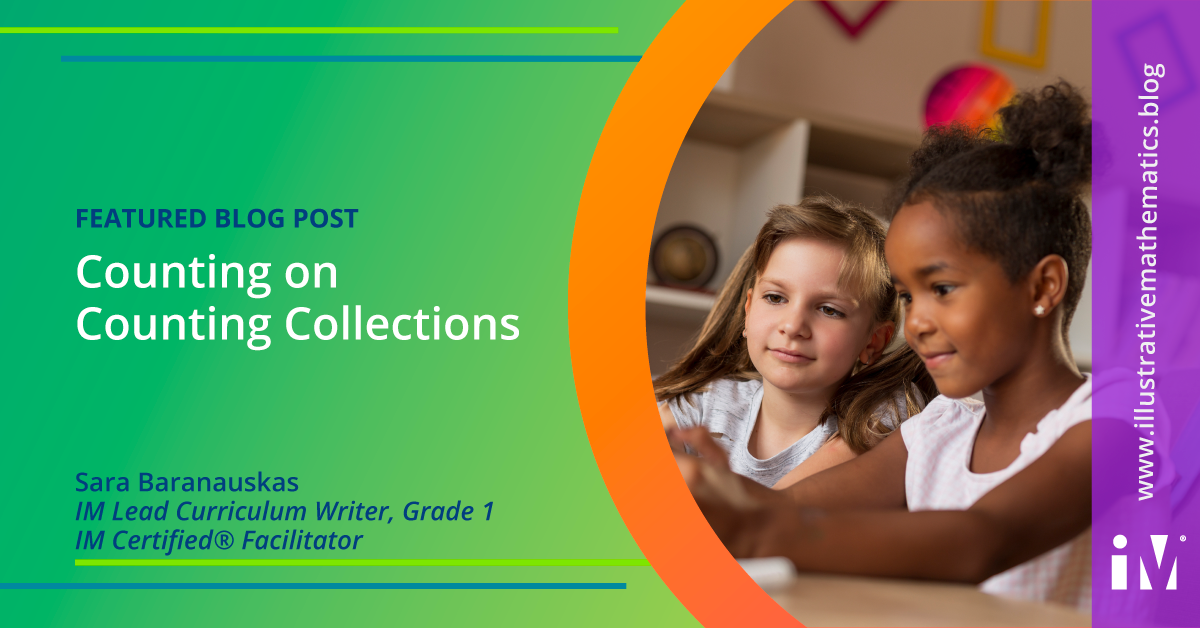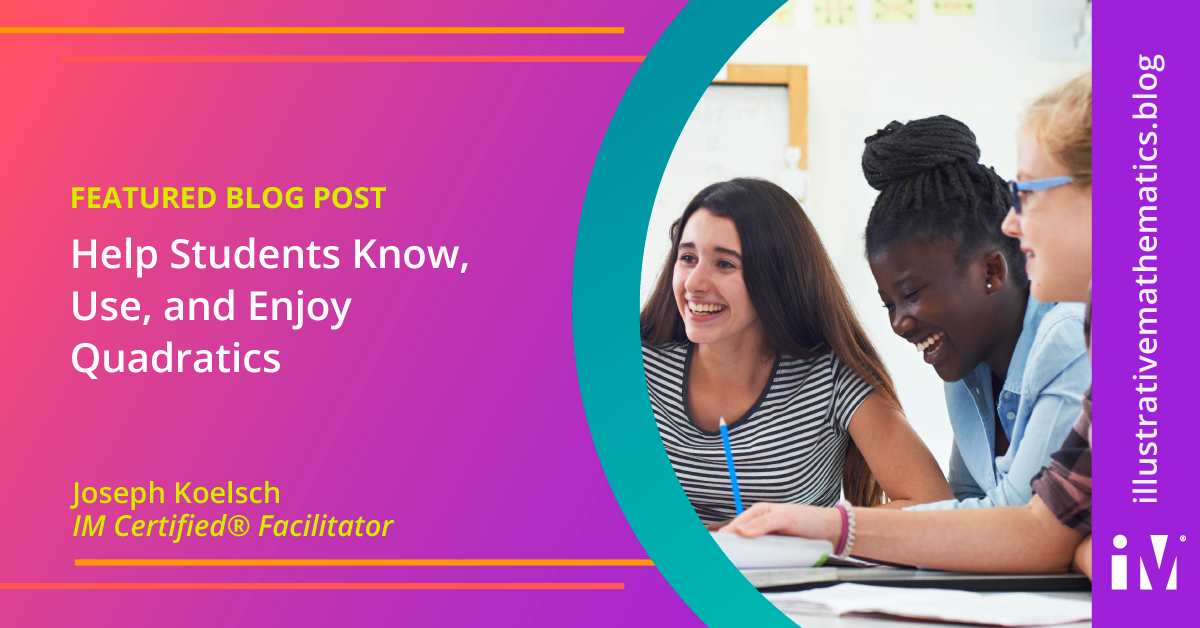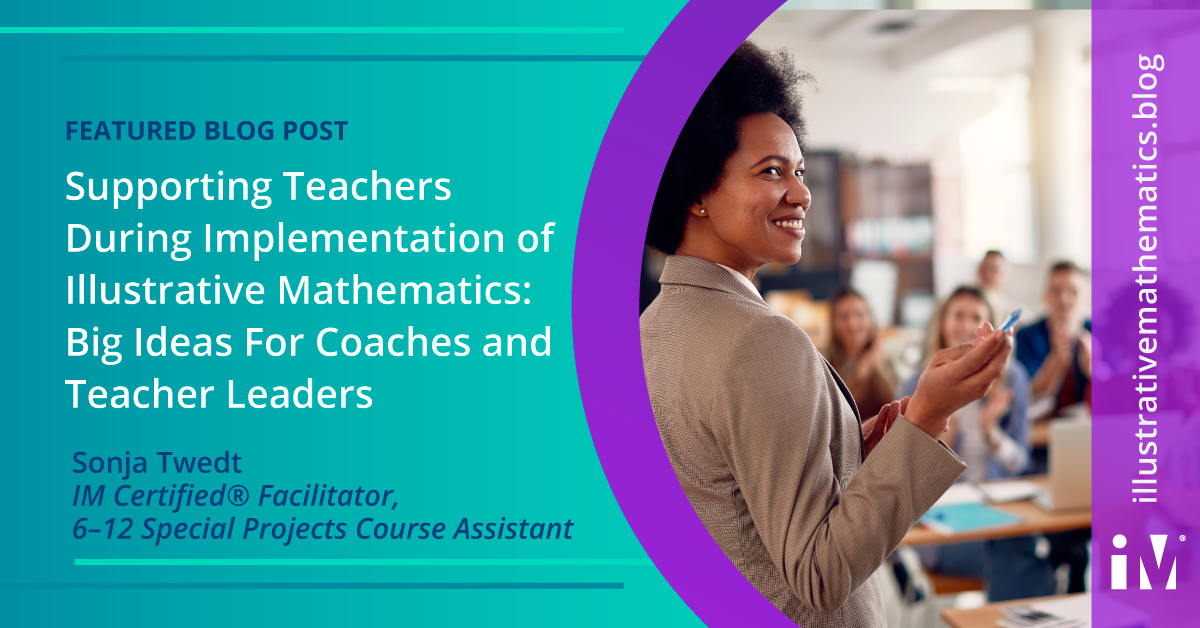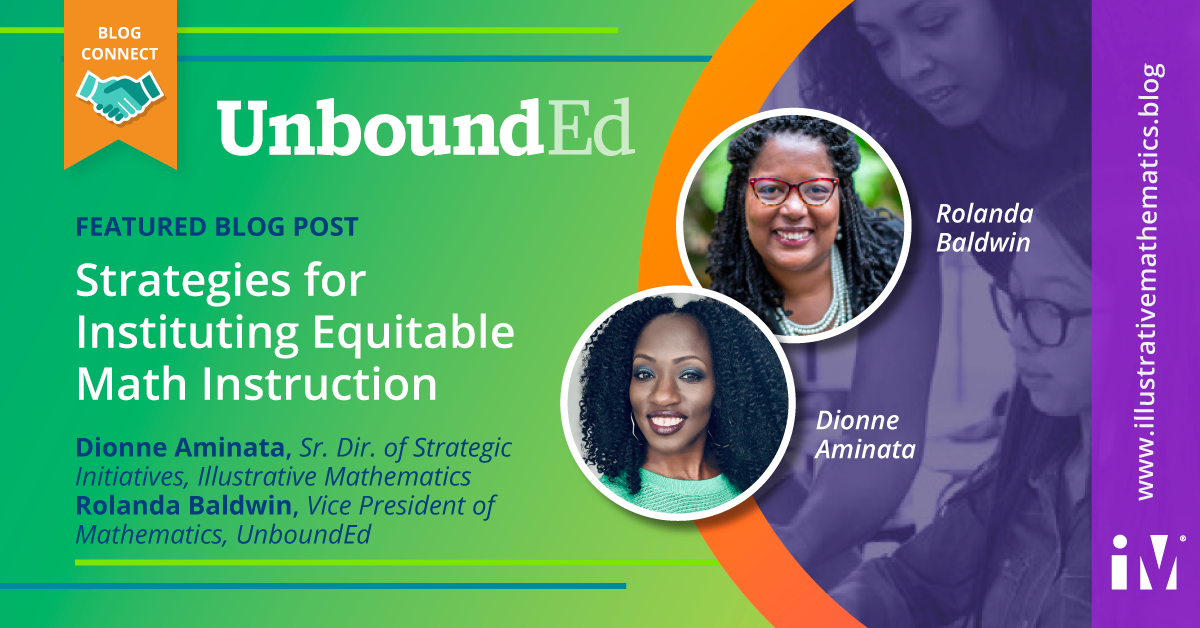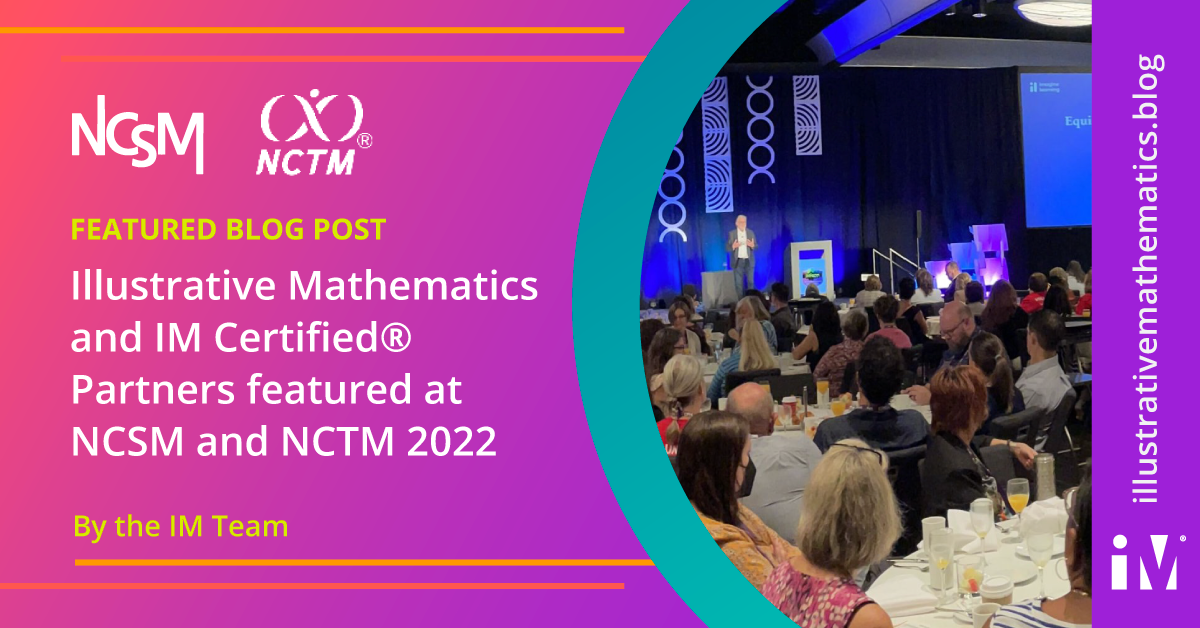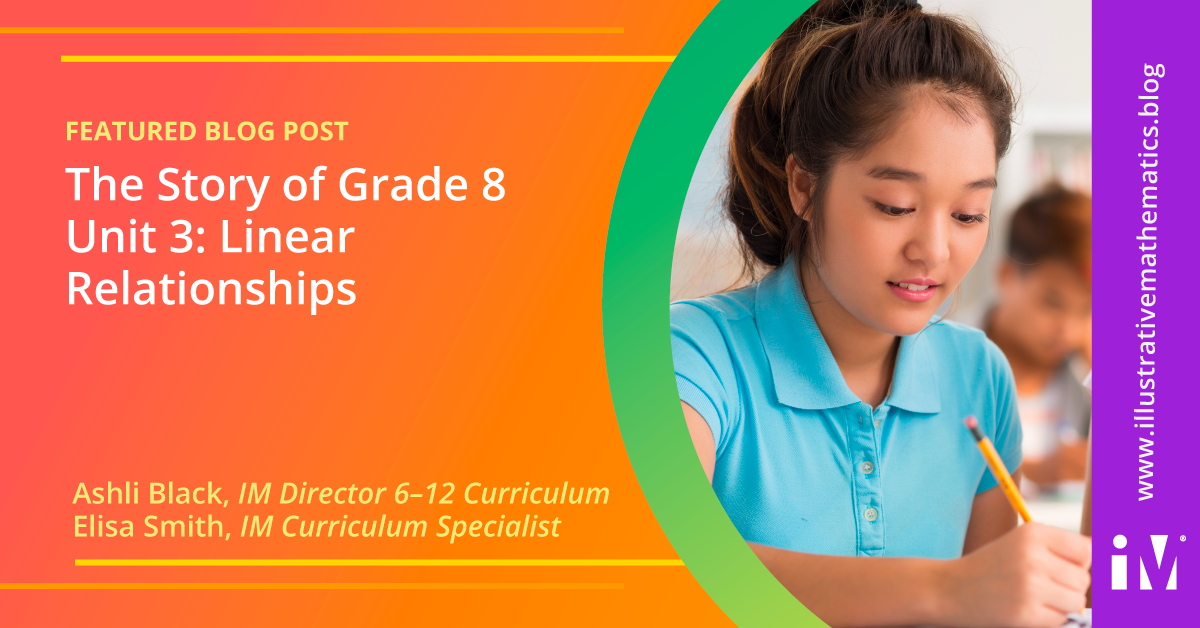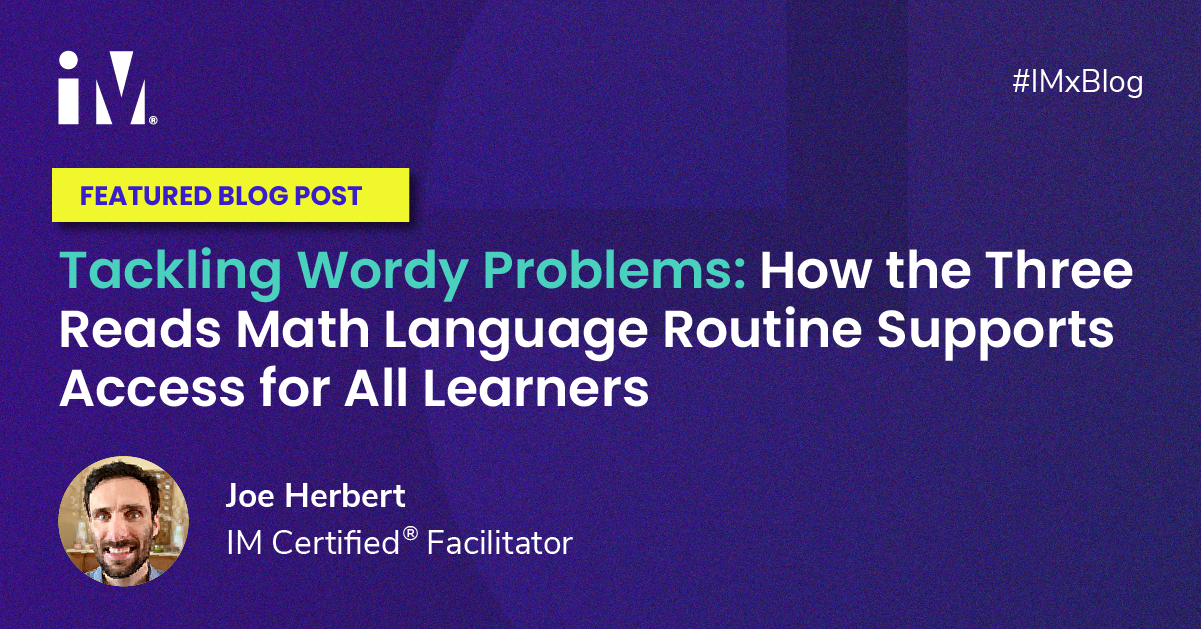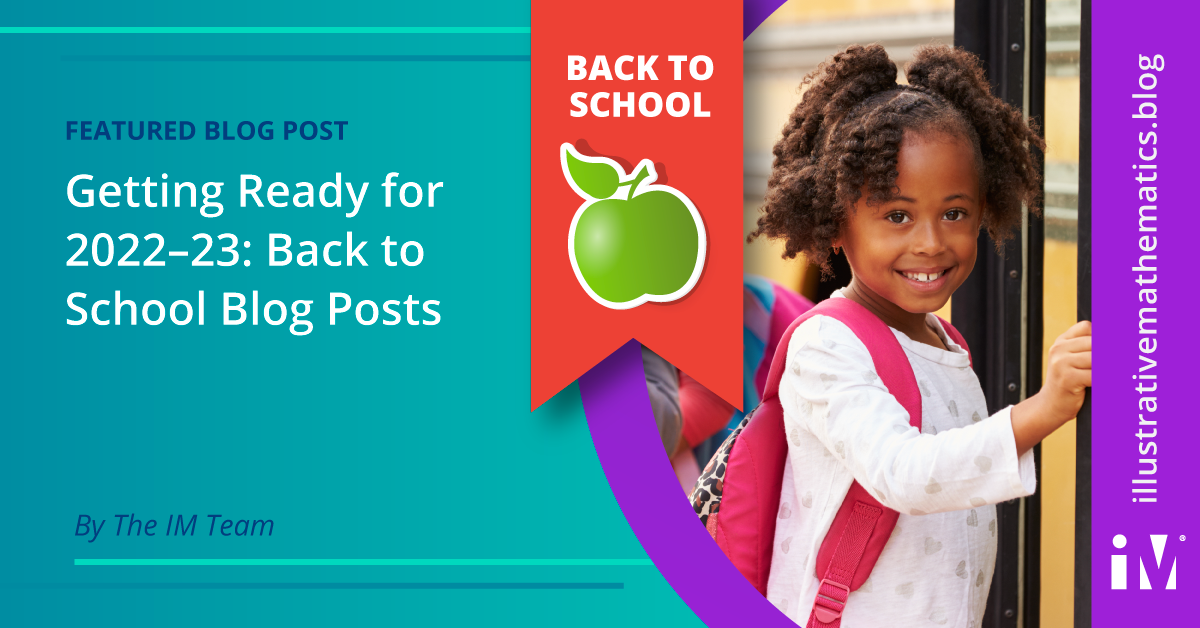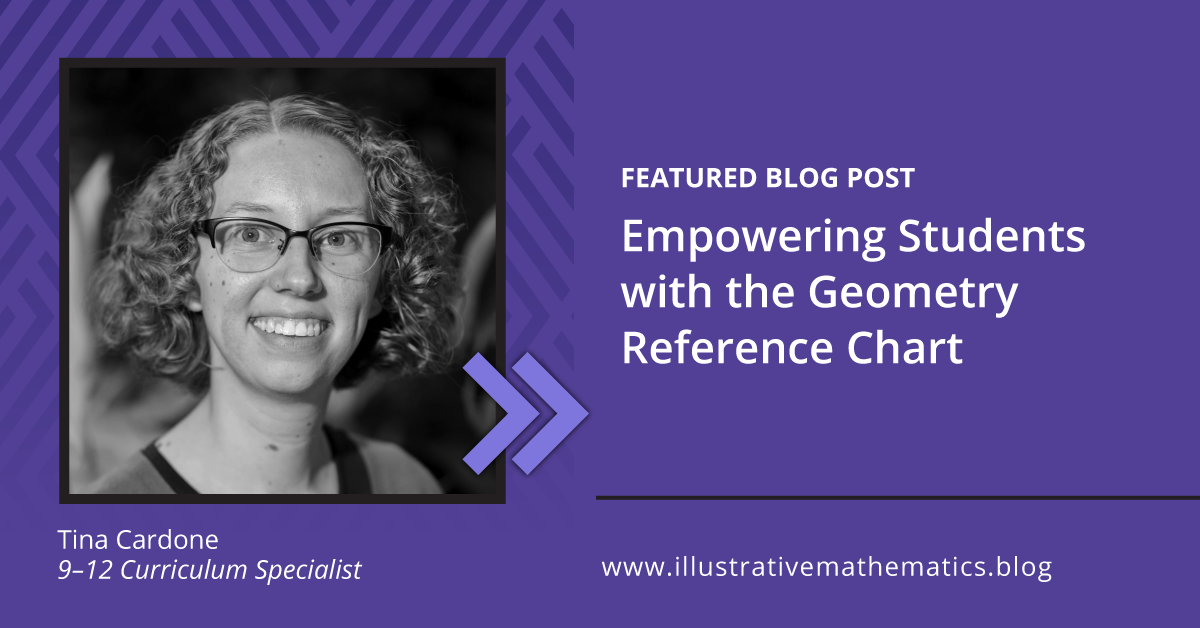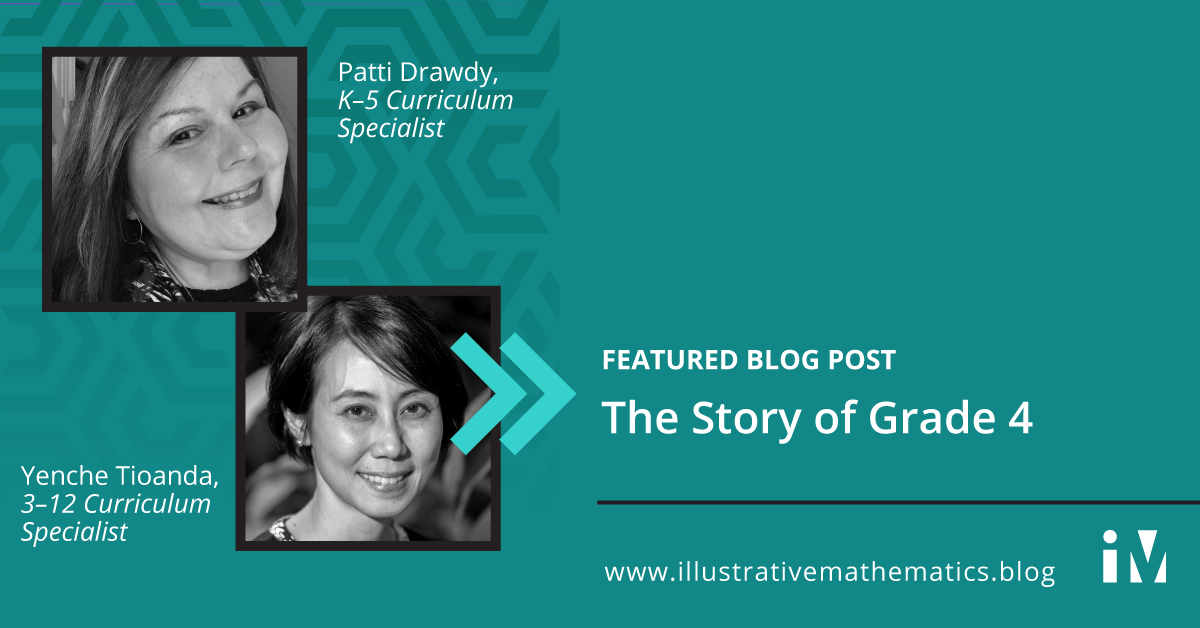IM Certified® Blog
Enacting IM K–5 Math™ Lessons in a Grade 4 and 5 Special Education Class
By Jody Guarino, Math Coordinator and Suzanne Huerta, SDC Teacher What does it look like for everyone in a school to learn together? This question, posed by Elham Kazemi, pushes us to consider that we, adults and educators,...
Unit 9 in IM Grades 6–8: Hidden Gems
By Lisa Matthews, IM Certified® Facilitator and PL Specialist Team for Grades 6–12 The IM curriculum is so thoughtfully designed and written that even those of us who have spent years with IM often find content that is new,...
The Power Of The Statistics and Probability Progression In Grades 6–8
By Sonja Twedt, IM Certified® Facilitator, IM 6-12 Writing Team Special Projects Course Assistant “In the digital era, data is the new oil.” —Srini Vemula I can’t think of many middle school students I know who are not...
Beyond Curriculum Adoption: A Vision of the IM Classroom
By William McCallum, IM CEO Here at IM we are excited by and proud of the reception IM K–12 Math™ is getting. As more and more districts adopt it, we are thinking about how to support them. What are the next steps? Our...
Coherence between Grade 8 and Algebra 1
By Courtney Ortega, IM Certified® Facilitator I was recently in a meeting where a participant declared, “Grade 8 and Algebra 1 basically have all the same standards.” Have you ever wondered this yourself? Have you heard...
Exploring the Lesson Synthesis: When do I actually teach?
By Lizzy Skousen, 6–12 Curriculum Writer, IM Certified® Facilitator During a problem-based lesson, the teacher does a lot of listening while monitoring student learning. When teachers are introduced to a problem-based...
Co-Creating an Authentic Math Community
By Meredith Dadigan Abel, IM Certified® Facilitator It is magical to be in a classroom with a strong math community. In this classroom, the brilliance of all students prevails. Students and teachers share a unanimous belief...
The Problem of “Fewer”: Using Centers and the 5 Practices to support students in their production of complex math vocabulary
By Margaret Betts, IM Certified® Facilitator If story problems are your teacher kryptonite, you aren’t alone. Story problems are mathematical situations expressed with words. The element of reading creates an added layer of...
Centers in Kindergarten: Purposeful Play and Authentic Assessment
By Cheryl Fricchione, IMCF and Implementation Development Team Member A quick Google search for “kindergarten math centers” produces over 20 million results: everything from tips to make centers work to theme-based...
Representations in the Story of Mathematics
By William McCallum, IM CEO co·her·ence noun the quality of being logical and consistent. the quality of forming a unified whole. One of the things I am proud of about IM K–12 Math™ is its coherence. This shows up in many...
Looking back at 2022: Year-End Closeout Message from Bill McCallum
2022 was a remarkable year of growth and achievement at IM. Our employees are energetic, inspired, and committed to our vision of a world where all learners know, use, and enjoy mathematics. I couldn't be more proud of what...
Counting on Counting Collections
By Sara Baranauskas, IM Lead Curriculum Writer, Grade 1 and IM Certified® Facilitator Counting Collections is an engaging and playful mathematical routine that supports and builds students’ sense of mathematical identity...
Help Students Know, Use, and Enjoy Quadratics
By Joseph Koelsch, IM Certified® Facilitator “I’ve said it before: equations are the devil’s sentences. The worst one is that quadratic equation, an infernal salad of numbers, letters, and symbols.” - Stephen Colbert Did...
Supporting Teachers During Implementation of Illustrative Mathematics: Big Ideas For Coaches and Teacher Leaders
By Sonja Twedt, IM Certified® Facilitator, 6–12 Special Projects Course Assistant Are you an instructional coach or teacher leader in a district that is adopting Illustrative Mathematics? If so, you’ve likely found yourself...
Exploring Ratio Reasoning with Student Work
By Tashana Howse, IM Certified® Facilitator The relationship between fractions, ratios, and proportions is introductory to students' development of the study of Algebra. Therefore, it is important for students to engage in...
Strategies for Instituting Equitable Math Instruction
Dionne Aminata, Senior Director of Strategic Initiatives, Marketing, Illustrative Mathematics Rolanda Baldwin, Vice President of Mathematics, UnboundEd Illustrative Mathematics and UnboundEd both agree that achieving racial...
Illustrative Mathematics and IM Certified Partners featured at NCSM and NCTM 2022
Members of the Illustrative Mathematics team recently attended two national conferences for math educators: NCSM (Sept 26–28, 2022) in Anaheim, CA, and NCTM (Sept 28–Oct 1, 2022) in Los Angeles. We enjoyed meeting so many...
Promoting Change: Reflections from the UnboundEd Five-Day Standards Institute™ 2022
By Catherine Castillo, IM Mathematics Product Specialist In her book Culturally Responsive Teaching and the Brain, Zaretta Hammond states, “Engaging in reflection helps culturally responsive teachers recognize the beliefs,...
The Story of Grade 8 Unit 3: Linear Relationships
By Ashli Black and Elisa Smith Grade 8 is a year marked by shifts in mathematical focus. Where grades 6 and 7 introduce students to negative numbers and using them in operations, grade 8 introduces them to irrational...
Creating Collaborative Math Classrooms
This blog post was written by William McCallum, co-founder and CEO of Illustrative Mathematics, and originally posted on the ImagineLearning blog. Collaboration is a core value at Illustrative Mathematics. Creating a...
Tackling Wordy Problems: How the Three Reads Math Language Routine Supports Access for All Learners
Joe Herbert, IM Certified® Facilitator “These problems are great, but they’re just so wordy. My students can’t handle all that reading!” Does this sound familiar? If so, you’re not alone! Many students and teachers struggle...
Getting Ready for 2022–23: Back to School Blog Posts
How do you get ready for a new school year? There is a lot to do, physically and emotionally. We hope you start the 2022–23 school year feeling rested, rejuvenated, and prepared. To support you, we have curated a collection...
Empowering Students with the Geometry Reference Chart
By Tina Cardone Geometry class can feel like word salad, with a heavy sprinkling of notation on top. Students need to both process and produce mathematical language in the vast majority of the tasks they work on. Here is a...
The Story of Grade 4
By Patti Drawdy and Yenche Tioanda “Why not start the year with place value?” Kaneka Turner, Grade 4 Lead Writer, hears this question often. Isn’t making sense of and operating on large numbers pretty essential in grade 4?...
